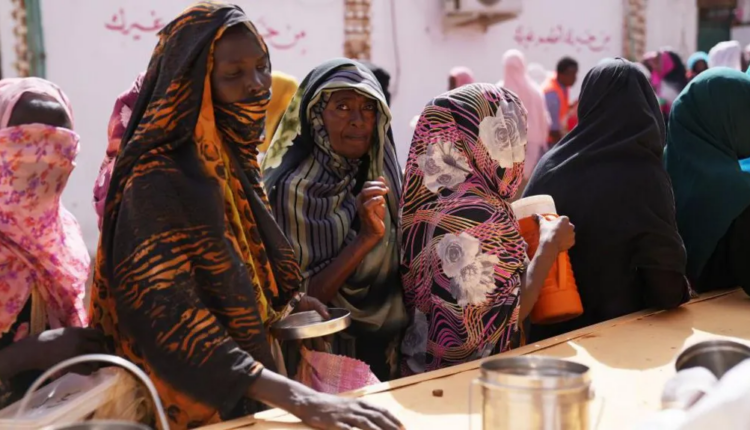The freezing of US humanitarian assistance has forced the closure of nearly 80% of the emergency food kitchens that provided meals to people affected by Sudan’s civil war.
Aid volunteers revealed that President Donald Trump’s executive order, which halted US Agency for International Development (USAID) contributions for 90 days, led to the shutdown of more than 1,100 communal kitchens. Nearly two million struggling Sudanese now face severe food shortages.
Since April 2023, the conflict between the Sudanese army and the paramilitary Rapid Support Forces has killed tens of thousands, displaced millions, and left many on the brink of famine. Local activist groups, known as emergency response rooms, had set up food kitchens to support affected communities. However, the aid freeze has left many without resources.
“People are knocking on volunteers’ doors,” said Duaa Tariq, one of the organizers. “People are screaming from hunger in the streets.”
Last month, the Trump administration abruptly suspended all US aid to evaluate whether it served American interests. The administration also initiated the dismantling of USAID. The State Department announced an exemption for emergency food assistance, but Sudanese aid groups remain confused about its practical implications. Many fear that cash assistance, which the communal kitchens rely on, will not resume. USAID had provided 70-80% of the funding for these programs, making the closure of the kitchens a severe setback in tackling the hunger crisis.
During the early stages of the conflict, the kitchens relied on community and diaspora donations. Later, international agencies, including USAID, provided funding. Andrea Tracy, a former USAID official, called the aid freeze a “huge setback” and established the Mutual Aid Sudan Coalition to collect private donations.
USAID, under its former head Samantha Power, had started funding local groups directly instead of relying solely on traditional aid channels like the UN. This approach was groundbreaking, Tracy noted, as it had only been attempted before with the White Helmets in Syria.
For Tariq and her team, the funding cut has made it impossible to stock food for the 25 kitchens serving six neighborhoods in Khartoum. She warned that they were unprepared for worsening conditions as the army advanced into RSF-controlled areas. Looting and sieges further worsened the situation, leaving most kitchens closed. Some volunteers are trying to secure food on credit from local fishermen and farmers, but they expect mass starvation soon.
The Mutual Aid Sudan Coalition is now working to fill the gap left by USAID. “We can support the emergency kitchens for now,” Tracy said, “but private donations will have to do much more because even if humanitarian aid resumes, it won’t return to previous levels.”
A former USAID partner acknowledged the impact of these grassroots groups. “These volunteers challenged us to work differently, and we responded. Now they are exhausted, traumatized, and underfunded, just as we were scaling up to help them.”
The State Department has not provided clear answers about Sudanese aid waivers, stating only that successful applicants received direct information. “The aid review process is not about ending foreign assistance but restructuring it to benefit the United States,” a spokesperson told the BBC.
The World Food Programme (WFP) confirmed that its 13 existing Sudanese grants with USAID received waivers, but uncertainty remains over future funding. The US was Sudan’s largest single donor in 2024, both through direct contributions and support for the UN’s Sudan Humanitarian Response Plan.
Top UN officials warn that Washington’s policy shift will affect not only Sudan but also neighboring countries hosting over two million refugees. Rania Dagesh, WFP’s assistant executive director, reported that refugee camps in South Sudan are struggling. “I have seen people who fled conflict but not hunger—until now,” she said. The refugee influx is straining already scarce resources.
UNHCR regional bureau director Mamadou Dian Balde confirmed that refugee camps in Chad and Egypt also face extreme shortages. “We are struggling. It’s extremely difficult,” he said. Local communities have welcomed refugees, but resources remain limited. In South Sudan, a country where 60% of the population faces emergency hunger, an additional one million refugees worsens the crisis.
Many displaced families survive on just one meal per day, prioritizing children and the elderly. “But you see them growing weaker in front of you—malnourished children and mothers who can’t produce breast milk,” Dagesh observed.
Most refugees are women, children, and the elderly. Many men were either killed or disappeared. Those who fled did so to save their lives and protect their children. With little to no aid available, some refugees attempt to sell firewood, but this exposes them to harassment, violence, and even rape.
Many of these refugees once lived in Sudan’s agricultural regions. War destroyed their homes and livelihoods, forcing them into displacement. While they hope for peace and a chance to return home, the ongoing conflict, now in its second year, offers little hope.
As hunger worsens and emergency food services collapse, more Sudanese will likely flee to neighboring countries. Yet, humanitarian agencies are already overwhelmed. UNHCR confirmed that its donor appeal in 2023 yielded only 30% of the needed funds, forcing severe cutbacks, including reductions in food and water supplies.
The US aid freeze and resulting uncertainty have disrupted global relief efforts. UNHCR officials are still assessing the full impact of these changes. “We are working with partners to understand the scale of the damage,” Balde told the BBC.
Faced with impossible choices, some refugees seek asylum in third countries, including Gulf states and Europe. “Many are embarking on dangerous journeys,” Balde warned.
With no ceasefire in sight, the collapse of Sudan’s emergency kitchens signals deeper humanitarian suffering and a growing refugee crisis. Aid agencies that could have helped are overwhelmed, and funding gaps make future assistance uncertain.
The ongoing war has left entire communities devastated, and relief organizations struggle to meet the rising demand for food and shelter. Without immediate intervention, Sudan’s hunger crisis could reach catastrophic levels, pushing more civilians into displacement and uncertainty.


Comments are closed.